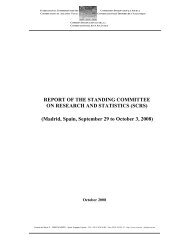REPORT OF THE 2008 ICCAT WORKING GROUP ON STOCK ...
REPORT OF THE 2008 ICCAT WORKING GROUP ON STOCK ...
REPORT OF THE 2008 ICCAT WORKING GROUP ON STOCK ...
You also want an ePaper? Increase the reach of your titles
YUMPU automatically turns print PDFs into web optimized ePapers that Google loves.
WG Stock Assessment Methods – Madrid <strong>2008</strong>2.3.4 Other informationOne indicator of overcapacity is a stock for which fishing mortality is estimated to be greater than F MSY . Table11 lists the stocks that would be classified has having overcapacity according to this indicator.One way in which a minimum estimate of overcapacity could be obtained is by computing:Overcapacity = (Harvest Capacity) - (Quota) ≈ (Catch) - (Quota)With the exception of SWO-M and YFT, the stocks in Table 11 have country-specific quotas or catch limits, sothat overcapacity can be computed (see Table 12). It should be noted, however, that in cases where quotas areinconsistent with achieving the Commission’s objective of rebuilding to B MSY , these estimates of overcapacityare even more strongly negatively biased. Such is likely in the case for bluefin tuna.3. Review of implementation of quality control procedures3.1 Assessment software catalogueOne of the tasks that the <strong>ICCAT</strong> Secretariat has to accomplish is the revision of the software used in theassessment of stocks to be included in the <strong>ICCAT</strong> catalogue. As inheritance of his previous position in theSecretariat, at present, Dr. Restrepo chairs the reviewing Committee. The Group requested him to continue atleast one more year until the new expert is contracted by the Secretariat and the new person in charge will takeover this task.It was noted that the procedure for cataloguing and reviewing new software is not well known by the <strong>ICCAT</strong>scientists. In order to widespread the knowledge on the cataloguing procedure, the Group agreed that theSecretariat will send the requirements of the documentation for the new software and the procedure followed bythe reviewing Committee to the <strong>ICCAT</strong> head scientists. This was accomplished during the meeting.A request for the FLR (Fisheries Library in R) software to enter the <strong>ICCAT</strong> catalogue was considered. TheGroup recognized that the software is still under development but some of the routines are fully operational andhave been used to assess other stocks. Furthermore, it is very flexible and a valuable tool to explore forassessment and simulation of management strategies. In addition, there exists a lot of documentation illustratingits possibilities. It was decided to include the reference of the FLR web page in order <strong>ICCAT</strong> scientists canfurther explore it (http://flr-project.org).3.2 Manual for CPUE standardizationOne of the immediate plans of the past Assessment Methods meeting (2007) was to develop a CPUEstandardization manual which could be used as a guideline for scientists attending the working groups. Due totime constraints as well as lack of human resources, the aforementioned manual task could not be accomplished.The Working Group agreed that if funds are available, the Secretariat should contract an external consultant toperform the task. Alternatively, a Contracting Party could engage a national scientist for developing the CPUEstandardization manualFurthermore, the Group recommended to the SCRS to hold a meeting of the Assessment Methods WorkingGroup exclusively focused on CPUE standardization which is a problematic issue from the point of view of thediversity of the models applied.3.3 Technical glossaryThe Working Group noted that the technical glossary of assessment terms has not been updated since 1999. Itwas decided to work out a preliminary draft list of technical terms appearing in the <strong>ICCAT</strong> working groupreports with their corresponding definitions, which would be distributed to all the scientists between now and theSCRS meeting for improvement and adoption. The draft list is included as Appendix 4.10
















